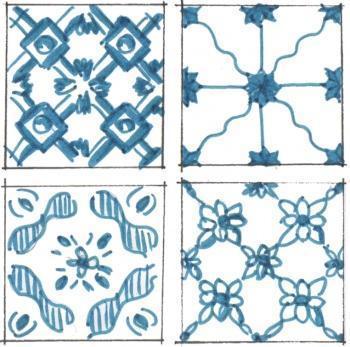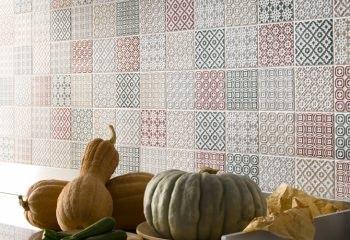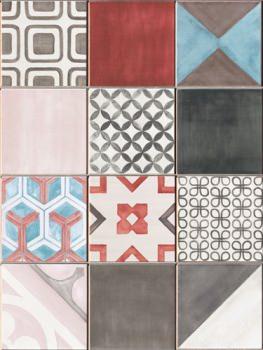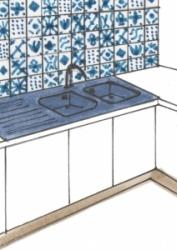Geometry and imagination in the kitchen tiles
Post from EditorialsFor those who would like to dare with floor and wall coverings different from the usual, the tile manufacturers offer new colors, shapes and combinations.
Decorative tiles for the kitchen: azulejos
Originally the Portuguese tiles representing the azulejos, squared ceramic tiles blue and white, decorated with different geometries and designs, used for external cladding of buildings typical of the Portuguese architecture. Now, geometric patterns, such as those of the traditional azulejos, have been reinterpreted in a vintage-chic by manufacturers of ceramic tiles, inspired by Mediterranean and arabesque motifs, but also, for example, by coats of arms or naturalistic motifs such as patterns of flowers, wreaths and branches intertwined.
Now, geometric patterns, such as those of the traditional azulejos, have been reinterpreted in a vintage-chic by manufacturers of ceramic tiles, inspired by Mediterranean and arabesque motifs, but also, for example, by coats of arms or naturalistic motifs such as patterns of flowers, wreaths and branches intertwined.
In this article we will see some inspiration for the walls and floors of the kitchen, waiting for the Cersaie 2014 exhibition, to be held in Bologna in September.
 The suggested match of geometric patterns completely different one from another: we pass from the warm tones (red, brown, antique ivory) to colder ones (blue, gray and white), forming a patchwork made of circles and squares, triangles and diamonds, hexagons and octagons, making an art out of geometry.
The suggested match of geometric patterns completely different one from another: we pass from the warm tones (red, brown, antique ivory) to colder ones (blue, gray and white), forming a patchwork made of circles and squares, triangles and diamonds, hexagons and octagons, making an art out of geometry.
The use of this type of coating is very versatile: they are suitable for kitchen, bathroom, dining room, stair coverings, but also in bars, restaurants and hotels.
Very varied and interesting is the collection by the designer Patricia Urquiola, Azulej by Mutina in glazed porcelain stoneware with cold digital printing that has 27 different patterns among them, ton sur ton, whose overall effect is extraordinary and endless combinations.
 For more punchy and dynamic environments such as the kitchen, are also well done the multicolored coatings, decorated with tiles of all colors, as proposed by the collection Batik by Hyper Ceramics: a ceramic coating 10 x 10 cm, available in plain white or in Deco version, developed in 5 colors (red, green, gray, beige and blue) always on a white background.
For more punchy and dynamic environments such as the kitchen, are also well done the multicolored coatings, decorated with tiles of all colors, as proposed by the collection Batik by Hyper Ceramics: a ceramic coating 10 x 10 cm, available in plain white or in Deco version, developed in 5 colors (red, green, gray, beige and blue) always on a white background.
 An alternative comes from the collection kreo Comp Patchwotk by Iris Ceramica, available in colors ranging from red to blue, in different geometric patterns that form a veritable patchwork.
An alternative comes from the collection kreo Comp Patchwotk by Iris Ceramica, available in colors ranging from red to blue, in different geometric patterns that form a veritable patchwork.
The use of these decorations on the coverings of the walls is widespread: it is sufficient to provide a wall of modest size decorated with these tiles to get immediately a welcoming, cheerful and colorful space. This type of coating is indicated, for example, behind or next to the kitchen sink. Its use on floors is rather more limited, if not well controlled, the floor so decorated risk of becoming too heavy.
For the floors, the combinations are very interesting in light colors Gredos, proposed by the Spanish company Vives, which offers real carpets in ceramic tiles of size 30 x 30 cm, to be combined with a plain color floor. The idea of creating these combinations, with tiles different one from the other, is good for those who have a little imagination and good taste, also by reusing old tiles, recovering from basements and attics still usable items that would otherwise end up in landfills. During the years 1960-1970 in fact, this type of decoration was very actual: it was used, however, only one color, at most two, and the decor was unique.
The idea of creating these combinations, with tiles different one from the other, is good for those who have a little imagination and good taste, also by reusing old tiles, recovering from basements and attics still usable items that would otherwise end up in landfills. During the years 1960-1970 in fact, this type of decoration was very actual: it was used, however, only one color, at most two, and the decor was unique.
Italian tiles: quality design
Italian ceramics are famous all over the world thanks to the schools of ancient traditions such as those of Vietri and Sassuolo.
Ceramics of Italy is the brand that identifies institutional sector and promotes the Italian ceramic productions in the world, for about forty years. The brand, promoted by Confindustria Ceramica, certifies the origin of the Italian product, marking those materials which are distinguished for design, technology and safety. Today there are about 70 companies that can boast of this brand. A peculiarity of the Italian ceramic is the attention to the environment: the ceramic is already a natural product, made with water and clay, but the production cycle has been improved thanks to the elimination of harmful materials in cooking and in the optimization cycle production. In addition, ceramics, at the end of their life cycle, they can still be re-used in other production cycles of construction. The products are therefore environmentally friendly, as well as certified by the EU Eco-label.
A peculiarity of the Italian ceramic is the attention to the environment: the ceramic is already a natural product, made with water and clay, but the production cycle has been improved thanks to the elimination of harmful materials in cooking and in the optimization cycle production. In addition, ceramics, at the end of their life cycle, they can still be re-used in other production cycles of construction. The products are therefore environmentally friendly, as well as certified by the EU Eco-label.
What to know when buying tiles
For the coating, it will obviously be necessary, excellent resistance to shock and wear and tear will instead be essential to ensure a good resistance to stains and chemicals and the consequent ease of cleaning.
79870 REGISTERED USERS










